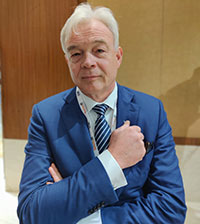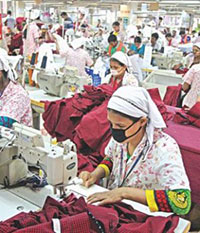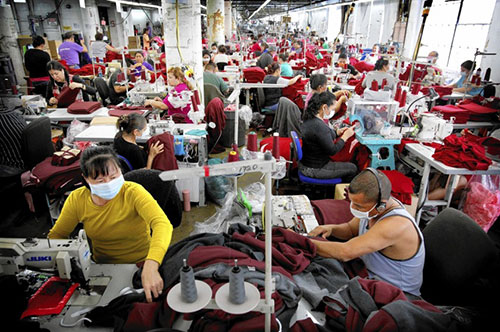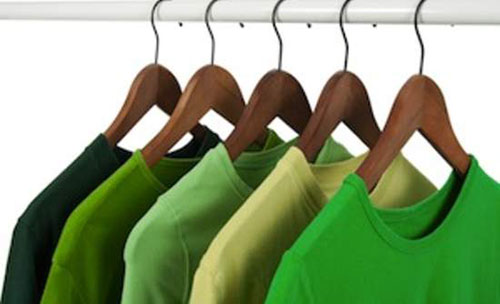FW
 Alexander, the Reinach, Switzerland-based diversified provider of dyes and specialty chemicals, serves the branded and performance textiles, packaging and paper, and coatings, adhesives and sealants markets globally. The leading company operates a highly integrated, customer-focused platform that delivers specialized performance and color solutions in over 100 countries. With 3,000 employees spread over 35 countries and 26 production sites the company has created a niche in its space. Alexander Wessels, CEO, Archroma speaks to Fashionating World in an exclusive interview and elaborates on the company’s operations, products and sustainability in the dyestuff industry.
Alexander, the Reinach, Switzerland-based diversified provider of dyes and specialty chemicals, serves the branded and performance textiles, packaging and paper, and coatings, adhesives and sealants markets globally. The leading company operates a highly integrated, customer-focused platform that delivers specialized performance and color solutions in over 100 countries. With 3,000 employees spread over 35 countries and 26 production sites the company has created a niche in its space. Alexander Wessels, CEO, Archroma speaks to Fashionating World in an exclusive interview and elaborates on the company’s operations, products and sustainability in the dyestuff industry.
Tell us more about Archroma?
Archroma is the largest supplier of chemical and dyes to the global textile and paper industries. We are a major advocator of sustainability and drive the efficiency of our natural resources which enables us to reduce production costs.
What is the USP of your products?
We invest a massive amount of capital in sustainable processes. Besides, we scientifically map new methods to optimise our process and devise new sources of dyeing. Our dyes are made from natural waste from the color red. Though many other suppliers make similar things but they neither have the required scientific back up nor do they invest much in new solutions.
Have you been able to convince everyone that sustainability and cost are not mutually exclusive?
Yes, we have. Archroma has made these investments to help manufacturers across the world. The use of our machines is growing globally. In Bangladesh, the market share of our systems has grown from 6-7 per cent to 40-50 per cent. We use advanced technologies that reduces the usage of fiber and energy driving down overall manufacturing cost.
Which country leads in sustainability? Where is India positioned?
I don’t think any particular part of the world is more sustainable than the other. It is more related to individual brands. Brands like Patagonia, Adidas make consistent investments in sustainability. India too has the potential to be the leader in sustainability if it invests more in aspects like technology, production, etc. It can also lead in cotton recycling and be a sustainable user of cotton.
Fashion is perceived as the second most polluting industry after fossil fuels. Please Comment?
That is not the case. Fuels, agriculture and energy are known to be more polluting than textiles. The carbon dioxide emissions from the textile industry result in only 6 per cent of global emissions. Though the industry uses a lot of water particularly in water pressured areas like Bangladesh, Pakistan, India, some parts of China, we have introduced solutions that help save water. For example, technologies used in denim dyeing save around 90 per cent of water.
However, most products still consume a lot of water. Why?
This is the responsibility of the entire industry. To address this, brands need to start selling eco-friendly apparels instead of cheap clothing. They need to provide good value for product. There are also a couple of corporate initiatives like sustainable peril coalition that we are committed to. However, there is still a lot to be done on different levels to become more sustainable. The current government’s Make in India initiative enables us to capture this fast.
With a slowdown, customers are not willing to pay beyond a certain amount for apparels. Does this affect your capacity to innovate?
Though ongoing trade wars are not stimulating global growth, they are providing opportunities to countries like India and China to increase domestic demand. India is likely to become a bigger consumer market than Europe in the next 10 to 20 years. So, we need to take these challenges as an opportunity to grow.
With global supply chains rebalancing, re-shifting and restructuring, where do you see Asia and particularly India, Bangladesh in this context?
In the short term, Vietnam, Bangladesh, India will profit from whatever is happening. However, in the long term, if this regional trade blocks continue, trade on the global level it will be restricted and be more localised. Asia will be the largest consumer market in the next few years and actually overtake every other continent. India and Bangladesh are really well positioned to take advantage of these situations given that they do not engage in any trade war what so ever.
As for reshoring, with changing landscapes the paradigm of manufacturing is also changing. Will it take away from Asia?
Of course, digitalisation will lead to different business modules where individualization will be possible and maybe within 10 years you can actually sit behind your computer to completely design your jeans yourself, maybe five years and two days later it is on your door post. That will certainly emerge as a part of the market, of course for the mass market there is no module.
How optimistic are you about overall growth because the GDP has dropped down to 3 per cent which is the worst in last 10 years?
Though many countries are going through a recession, there are signs of growth in some. We don’t predict the future of a company on the basis of a short recessionary cycle. We look for long term outlook.
At the micro level, how do you see apparel and textile industry, stacked up and growth going forward?
I am too remote to make a forecast on the domestic level. But, internationally the key is to stay competitive. Superior quality, good traceability and good sustainability will drive the industry forward.
What is your message as a global citizen?
Firstly, it is important for us to realise that it is not only about a green portion but taking big steps to make this industry truly sustainable. Our traders have solutions for complete circularity. There is no mass market or would never be mass market but I think every step if they take toward making their natural resources better, we should do and we are obliged to our children to do so and I think everyone in the textile industry who denies it is not worthy to be a leader.
"Most brands were willing to share initiatives for promoting living wages. They were also transparent about their limitations in producing in developing countries such as Bangladesh, Cambodia and Vietnam, as the wage-setting mechanisms and social dialogue in these countries are still at a nascent stage"
 Even after a year of Dutch financial institutions forming an unprecedented coalition to demand minimum living wages for workers, the wage landscape still remains a mixed bag with no single solution offered by two brands. A recent review of 13 investee apparel brands by Platform Living Wage Financials’ garment and footwear working group reveals so far only Adidas has improved its transparency initiatives from last year. Now, the brand not only provides an insight into wage structure but also reveals information about collective bargaining in its supply chains and operation of its grievance and remediation mechanisms. The brand also pilots an employee credit cooperative that allows its factory workers to earn extra income through dividends and profit sharing.
Even after a year of Dutch financial institutions forming an unprecedented coalition to demand minimum living wages for workers, the wage landscape still remains a mixed bag with no single solution offered by two brands. A recent review of 13 investee apparel brands by Platform Living Wage Financials’ garment and footwear working group reveals so far only Adidas has improved its transparency initiatives from last year. Now, the brand not only provides an insight into wage structure but also reveals information about collective bargaining in its supply chains and operation of its grievance and remediation mechanisms. The brand also pilots an employee credit cooperative that allows its factory workers to earn extra income through dividends and profit sharing.
Besides, it has created a standard-minute costing system that creates further transparency in the company’s product cost for materials, labor and overhead.
Some other brands surveyed by the group were seen to be in the maturing phase. These include: Asos, Esprit, Gildan, H&M, Inditex (which owns Zara), KappaAhl, Marks & Spencer and Puma. They scored between 20 and 30 points on transparency scale. Four companies scoring between 10 points to 20 points were classified as being in the developing phase. These included Asics, HanesBrands, Renner and VF Corp.
Most brands were willing to share initiatives for promoting living wages. They were also transparent about their limitations in producing in developing countries such as Bangladesh, Cambodia and Vietnam, as the wage-setting mechanisms and social dialogue in these countries are still at a nascent stage. However, the group expressed its desire for more ownership to be taken of living wage by brands, particularly in terms of sharing information from multi-stakeholder initiatives on their websites or annual reports. Similarly, it noted that brands need to move from effort-based reporting to impact-based reporting. Though many of them report about their corporate processes to mitigate human rights, few indicate about their impact on the brand’s operations.
According to the group, a living wage would not only help brands create reliable relationships with their suppliers but also foster a happy and healthy workforce.
"With sustainability gaining traction across the globe, fashion brands are going all out to align operations with better environmental practices. This was evident from all the fashion shows held last month in New York, London, Milan and Paris which focused on sustainability. Spanish fashion retailer Zara announced its plans to go organic by 2025."
 With sustainability gaining traction across the globe, fashion brands are going all out to align operations with better environmental practices. This was evident from all the fashion shows held last month in New York, London, Milan and Paris which focused on sustainability. Spanish fashion retailer Zara announced its plans to go organic by 2025. The brand also plans to make all its stores eco-efficient by the end of this year. This would enable it to reduce carbon emissions and reduce wastes.
With sustainability gaining traction across the globe, fashion brands are going all out to align operations with better environmental practices. This was evident from all the fashion shows held last month in New York, London, Milan and Paris which focused on sustainability. Spanish fashion retailer Zara announced its plans to go organic by 2025. The brand also plans to make all its stores eco-efficient by the end of this year. This would enable it to reduce carbon emissions and reduce wastes.
Promoting an ecological chain of thoughts
These initiatives are a major deviation from earlier times when brands did not focus so much on sustainability. They were more concerned about increasing profit margins which led them to churn out cheap clothing in bulk quantities. These clothes were then sold off in stores at a jet setting speed. However, faster production cycles resulted in increasing risk to labor health and huge waste accumulation as consumers began dumping garments frequently with changing fashion trends.
Waking up to the hazards of fast fashion, brands are promoting a more ecological chain of thought. Popular fashion retailers including H&M, Uniqlo, Benetton, Zara, etc, are making sustainability an intrinsic part of their value chain and ethos. For instance, H&M plans to use only sustainable cotton by 2020, Similarly, Japanese retailer Uniqlo announced plans to focus on five areas of action-change, energy efficiency, water stewardship, waste management and resource management as a part of its revised Environmental Policy introduced in June 2018. 
Slow fashion to replace fast fashion
Alongwith these initiatives, brands are considering alternate ways of being more responsible. They are opting for slow fashion, as against fast fashion, to become more sustainable. Uniqlo has developed a new technology in partnership with Japanese major Toray to incorporate recycled materials. The brand plans to collect pre-owned Uniqlo down products in Japan and send these to be recycled at its Toray facility.
‘Clothes on rent’ service is catching up. This reduces the purchase of excess clothes by the consumers, thus curtailing waste. The Clothing Rental, a rental service offers original pieces of clothing to its clients. The firm feels, the concept of renting clothes elongates their lifespan. It also leads to lesser production and promotes a sustainable way of being fashionable.
Changing shopping pattens
Consumers are realising the worth of living consciously. They are becoming more aware and sensitive to environmental issues. Brands too are educating consumers on efforts that can lead to positive shopping patterns. For instance, Uniqlo has introduced ‘Eco bags’ to replace plastic shopping bags. These bags are environment-friendly and help the brand to ensure a secure future.
For the first half of the year Ralph Lauren’s net profit was up 37.3 percent. Sales were up 2.3 per cent. Meanwhile Ralph Lauren resumed sourcing from Bangladesh. The American fashion company stopped producing garments in the Asian country in 2015, after the Rana Plaza collapse.
Ralph Lauren has ambitions to increase sales by a billion dollars by 2023. Marketing spend will go up by a 100 million dollars over the next five years. The aim is for half of the company’s growth to come from core categories — men’s shirting — and half from undeveloped categories like denim, wear-to-work, outerwear, footwear and accessories. The last few years have been about cutting costs including closing 50 stores, eliminating more than 1,000 jobs and removing three lines of management. The goal is to woo the next generation of consumers and increase gross margins by improving the core product (which makes up 60 per cent of overall revenue), amplifying under-penetrated categories (including women’s, outerwear and denim) and operating with discipline, which constitutes being more careful about discounts and promotions, more strategic when it comes to price, and cutting costs in creative-but-impactful ways. The brand targets working professional men in their early-to-mid 30s, new-to-the workforce women in their mid-to-late 20s, and the creative class.
Filatex is a game-changer when it comes to innovative products and the adoption of new technologies. The company is in the business of manufacturing synthetic filament yarns with a wide range of products like POY, DTY, and FDY in polyester to polypropylene crimp yarns. The new plant in Gujarat is a CP unit of 600 TPD capacity where the chips-to-yarn technology was abandoned and the manufacturing technology of melt-to-yarn directly from petrochemicals was adopted. The plant has given Filatex a strong foothold in the polyester yarns market. Once the process technology was absorbed, the product basket was expanded to add FDY and DTY using the state-of-art technology from Germany. Filatex has made rapid strides in exporting drawn textured yarn. Its present focus is on the polyester sector. Filatex is now in the process of adding bright polyester at its plant with the latest spinning and winding technology. In terms of future expansion plans, Filatex has been nursing the idea of establishing its own captive power plant by the end of the next fiscal year.
The company has managed to maintain an edge over its competitors due to consistent product quality and low operating cost. It takes pride in its energy-efficient operations.
Bangladesh’s exports declined by 17.19 per cent in October this year compared to October last year. Export earnings declined 6.82 per cent in the first quarter of the fiscal.
The readymade garment sector is not in good shape and it has created a huge negative impact on the economy. Factories are being shut, making thousands of workers jobless. More than 100 factories shut down operations in the first seven months of this year. About 60,000 workers have lost their jobs as garment factories have closed due to higher cost of production and lower prices offered by foreign buyers. Export earnings have declined mainly because of the decrease in foreign orders for apparel products. Additionally, Bangladesh is facing competition from Myanmar, India, Pakistan and Vietnam in the global market. While these competitors have devalued their currencies against the dollar, Bangladesh didn’t, and is losing orders and its competitiveness. While European countries are dealing with the recession, the US market is comparatively in good shape. However, Bangladesh has been unable to take advantage of the US market.
Bangladesh is the world’s second largest readymade garment exporter after China, with the sector accounting for more than half of manufacturing employment and around 84 per cent of the export earnings of the country.
Luxury brands are likely to retreat from Hong Kong due to the ongoing pro-democracy protests that have weighed on third-quarter sales growth at firms like Cartier and Hugo Boss. Sales growth for companies making goods like jewelry, high-end fashion or handbags would come in at the low end of expectations.
Luxury brands, which have around 1,000 stores in the Asian shopping hub, are likely to start shutting some permanently. Hong Kong, which once accounted for around five per cent of global luxury sales, is now closer to two per cent. While the demonstrations might be a temporary disruption, a more structural shift is at play in the shopping habits of well-off customers from the Chinese mainland whose Hong Kong spending have long been buttressed sector sales. Despite China’s economic slowdown, shoppers are continuing to spend heavily on luxury - but they are increasingly staying at home because of a weaker currency that has blunted their overseas firepower. Meanwhile China has cut import duties and sales tax, eroding the competitive price advantage of foreign destinations like Hong Kong, London and New York. Chinese shoppers now make up 35 per cent of all industry sales - and they are on course to account for 90 per cent of growth in the market this year.
Interfilière Paris will take place January 18 to 20, 2020. This is an event for materials and textile accessories for the lingerie, swimwear, and sport markets. The event will host 160 manufacturers of knits, laces, embroideries, textile accessories, textile designs, and fibers, offering a look ahead at the lingerie-making of tomorrow. An incubator for future thinking, it offers an analysis of consumer desires and predicts profitable market shifts. “This promises to be a memorable moment in time, suspended somewhere between dreams and exceptional artisanal skill. A unique selection of laces, embroideries, silks, designs and textile accessories is aimed at meeting the needs of lingerie buyers as well as those of a new type of buyer from the bridal and haute couture markets. A magical setting will shine a spotlight on all the creativity reflected in this precious craftsmanship. Innovative techniques in embroidery, macramé, crochet, and work with precious metal threads can be seen as well as a variety of ultra-creative uses of textiles and recycled looks.
The Exception, a unique space, has since 2013 highlighted exceptional craftsmanship and gathered exhibitors, artists, and designers around a unified theme, driven to inspire and look ahead. This edition, The Exception will reveal an inspiring pause built around the worlds of weddings and haute couture.
Even after the withdrawal of concessions under the Generalised System of Preferences (GSP), India’s apparel exports to the US have risen five per cent compared to the same period last year when the duty benefits were available.
In July 2019 the US terminated India’s designation as a beneficiary developing nation under the GSP trade program after determining that it has not assured the US that it will provide equitable and reasonable access to its markets.
The textile industry in India is subject to provisions of the WTO Agreement on Subsidies and Countervailing Measures, which stipulate that if a developing country member’s exports of a product have reached a share of at least 3.25 per cent of world trade of that product for two consecutive calendar years, it will be considered as export competitive in that product. As per this provision, India is obliged to phase out subsidies which are export contingent. And India intends to phase out export subsidies on such products over a period of eight years.
India’s leather exports to the US grew by about seven per cent in the last four months. The US-China trade war offers huge opportunities to Indian leather exporters to raise shipments to the United States.
"The latest edition of Global Fashion Drivers, created by Mds and sponsored by Everis reveals that personalisation, price reduction, sustainability, reorganisation of store network and full commitment to Rfid are some of the drivers of fashion business. In its ‘Global Fashion Drivers’ report sponsored by Everis, Mds analyses 10 drivers that mark the evolution of the sector. The document is based on the analysis of the information published by a sample of the one hundred largest and most representative companies in the fashion sector in the world. Mds submits companies to a comprehensive questionnaire that sums the key areas of their operations."
 The latest edition of Global Fashion Drivers, created by Mds and sponsored by Everis reveals that personalisation, price reduction, sustainability, reorganisation of store network and full commitment to Rfid are some of the drivers of fashion business. In its ‘Global Fashion Drivers’ report sponsored by Everis, Mds analyses 10 drivers that mark the evolution of the sector. The document is based on the analysis of the information published by a sample of the one hundred largest and most representative companies in the fashion sector in the world. Mds submits companies to a comprehensive questionnaire that sums the key areas of their operations.
The latest edition of Global Fashion Drivers, created by Mds and sponsored by Everis reveals that personalisation, price reduction, sustainability, reorganisation of store network and full commitment to Rfid are some of the drivers of fashion business. In its ‘Global Fashion Drivers’ report sponsored by Everis, Mds analyses 10 drivers that mark the evolution of the sector. The document is based on the analysis of the information published by a sample of the one hundred largest and most representative companies in the fashion sector in the world. Mds submits companies to a comprehensive questionnaire that sums the key areas of their operations.
US-China trade war impacts foreign trade
The report says, about 22 per cent respondents cite the trade war between United States and China as one of the factors that put a brake on their foreign trade in 2019. On the other hand, 32 per cent companies believed currency volatility to be the main culprit. In 2018, 38 per cent of the world’s top 100 fashion companies opened new markets, compared to only 8 per cent of the companies that chose to retreat into one.
foreign trade in 2019. On the other hand, 32 per cent companies believed currency volatility to be the main culprit. In 2018, 38 per cent of the world’s top 100 fashion companies opened new markets, compared to only 8 per cent of the companies that chose to retreat into one.
Uncertainty, promotions, consumption slowdown and ecommerce boom also impacted the profitability of the world’s largest retailers with 22 per cent of the fashion giants dropping their profits in 2018. A significant number of companies like Mothercare, Kiko Milano or OVS were forced to refinance their debt during the past year.
Mergers and acquisitions rule
Several new mergers and acquisitions made headlines last year. Around 41 per cent companies bought a stake in new company while 4 per cent of fashion groups switched hands. Around 5 per cent of them sold some of their brands while 7 per cent collaborated with new partners. Supply chains were redesigned with flexibility alongwith volumes, price and speed determining their design. These strategies helped brands establish greater control over production, either by creating structure around productive hubs, establishing new logistic hubs, setting up their own factories or betting on automation.
Brands take a break from sustainability
The report states, the Greenpeace Detox campaign in 2011, collapse of the Rana Plaza in 2013 and the Climate Summit in Paris in 2015 placed sustainability on the radar of large fashion and luxury companies in the last decade. However, this acceleration took a break in 2018 with only 30 per cent of the companies being a part of international lobbies committed to sustainability.
The speed of ecommerce, the entry of new generations of consumers and the change in shopping habits forced the traditional retailers to revamp their distribution systems. Almost half of the retailers closed their stores while two-thirds opened new stores.
New innovations
Almost 43 per cent have implemented Rfid in their structures. Nine percent of these have acquired a startup to strengthen innovation, five per cent have added new payment methods and 10 per cent of the industry giants implemented virtual reality.
Modified logo, identity
Five retailers and luxury companies modified their logo or graphic identity in 2018. On the other hand, concentration led to changes in corporate identities with the creation of new holding structures and name changes in the parent company.
Digital transformation restores brand loyalty
Loyalty and personalisation ceased to ensure fluid and personal communication between brand and consumer to create long-term relationships based on trust. However, digital transformation is now restoring brand loyalty and customisation at the center of the game.












